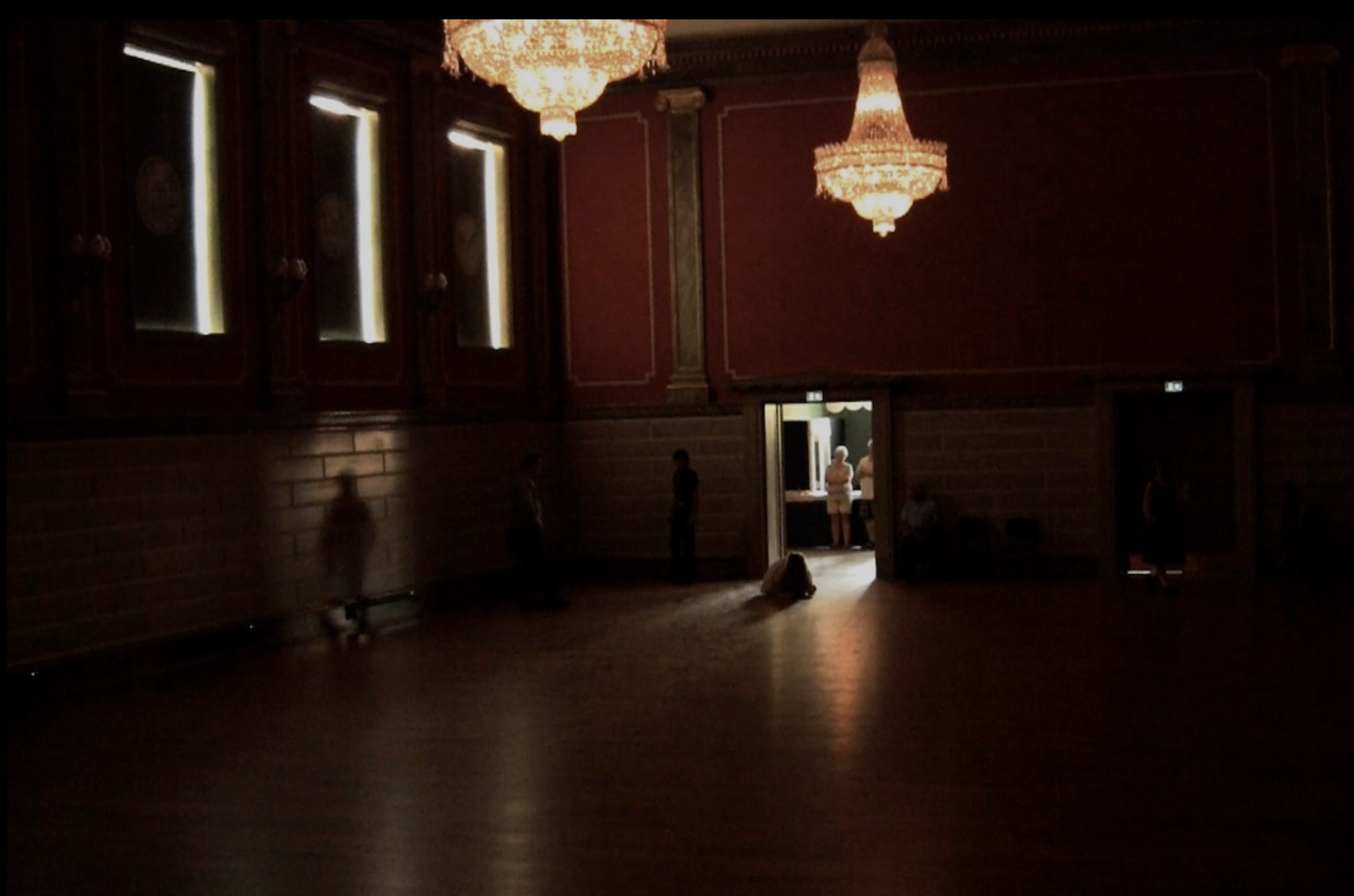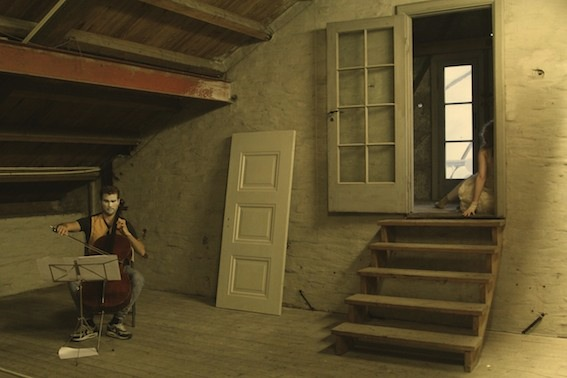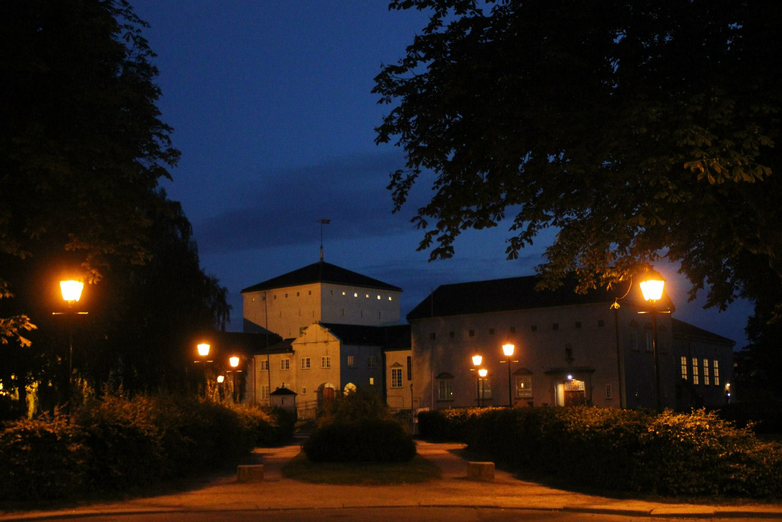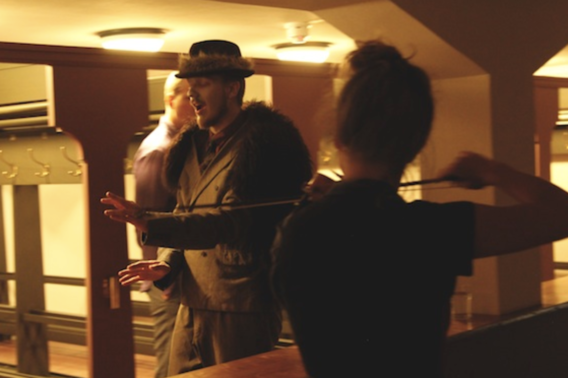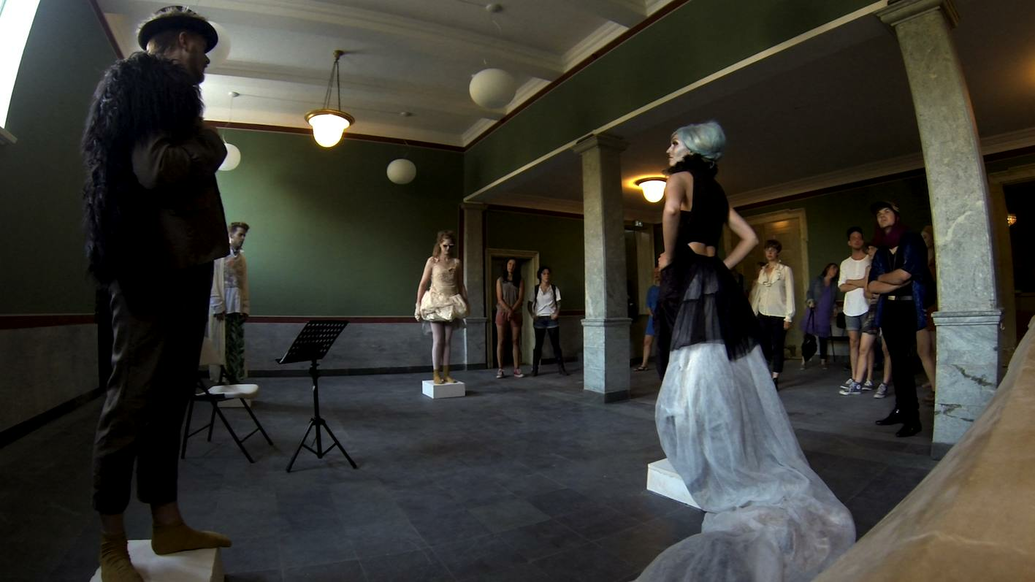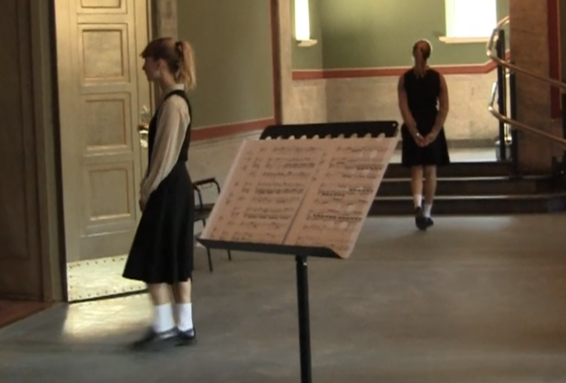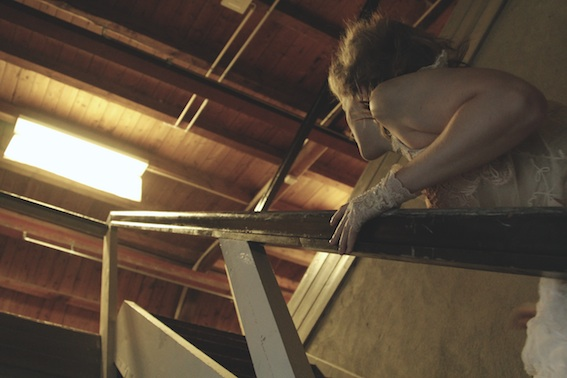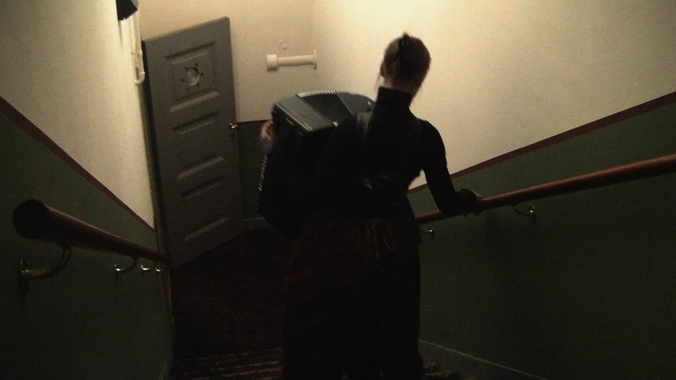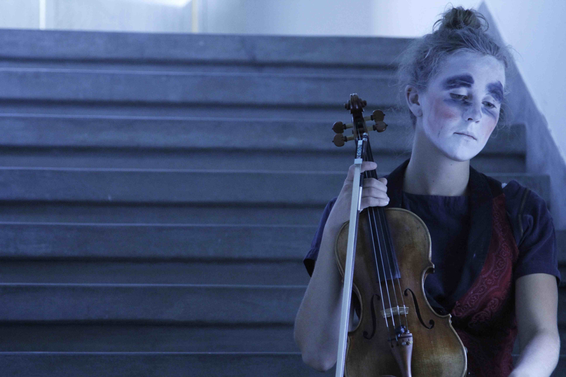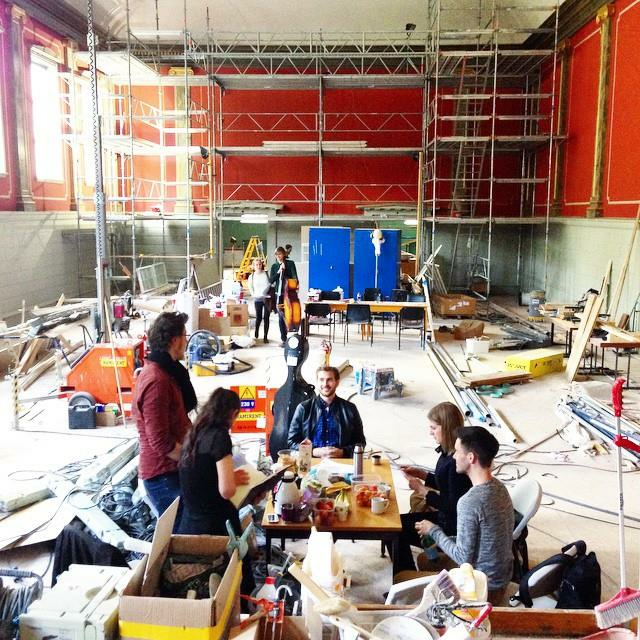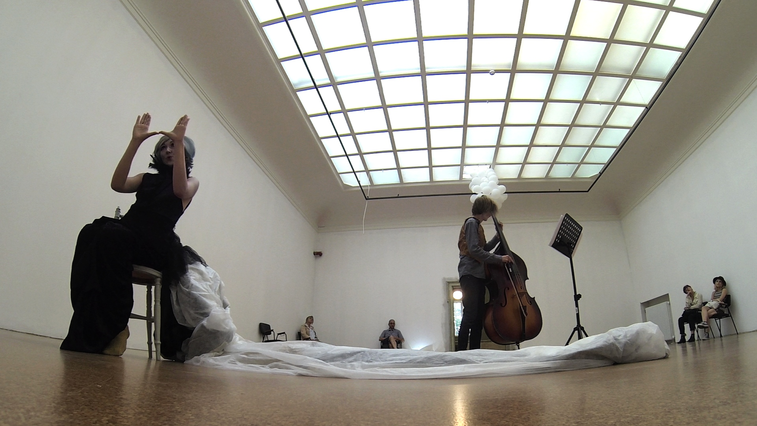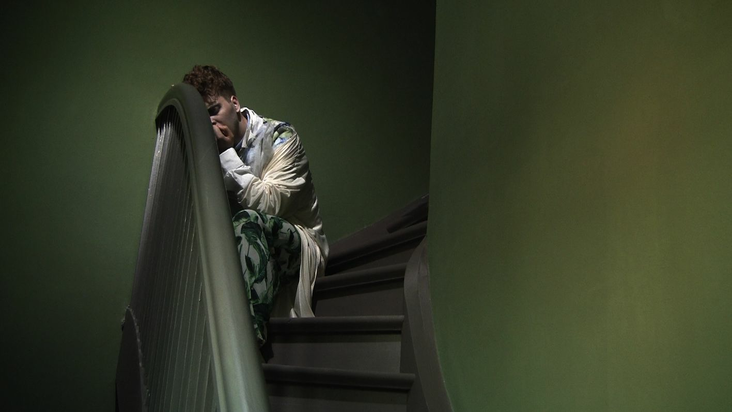As a supplement to this retrospective account of Schnitzler’s Dreams, I would like to connect to Meredith Monk and point out her contribution to site-specific musical performance. As Schnitzler’s Dreams is an ‘installation-opera’ with stories and characters it is more closely related to her work than my later works are.
When Meredith Monk created Juice (1969) in three different spaces, she wanted to bring the audience’s attention to spaces that were not usual performance locations. The spaces in turn inspired the stories that she would tell in the performances, and they informed the development of the characters in her pieces. This makes the performance site-specific. In Schnitzler’s Dreams the characters were what guided all the other artistic choices and just like in Juice, their development was informed by the space. What was different in Schnitzler’s Dreams was that even though there were narratives, the work was instead about the journey through and between the four stories, rather than being about the narratives as such. This development away from storyline and towards a spatial dramaturgy has expanded during my research and these days there are no characters in my works. The personalities of the performers shine through during the performance, but these personalities are not formally performed or characterised.
As my work is performed in fixed spaces, attention to change is given. The journeys are inside the spatial sound composition, and they take place in a limited space that is expanded by the physical and sonic exploration of its acoustics. With American Archeology (1994) Meredith Monk created a performance that journeyed across a big area. In her drawings for the work, she indicated the path and the direction the audience should move. In the performance the audience is physically activated and guided on a clear path that connects different spaces. This allows for a variation of distance between bodies and other performance elements. Similar to Schnitzler´s Dreams the reference points in Monk’s work are plotted at a distance to one another. The path the audience takes in Schnitzler’s Dreams is, however, freely chosen, which is supported by the fact that the space is limited. In other words, the path does not need to be fixed as the performance area is clearly defined by the building and many paths are possible when journeying through the different stories.
When we pay attention to our physical relation to space, we also become more aware of the performer-audience relation. Meredith Monk explores this in terms of scale and proximity. This concern is also related to the temporality of live performance as something that disappears but remains in the memory. In Juice she made use of this quality by inviting the audience to three different locations over a six week period where elements of earlier performances were revisited in different forms. Here, Monk gives special attention to details in the visuals of the performance. In Schnitzler’s Dreams costumes, objects and other visual scenography provided an insight into the characters’ ‘soul landscape’. Proximity and memory were explored by each audience member as they moved through the space and could hear different things happening in the various areas of the building, depending on their proximity to one of the characters. In my more recent work, the scenographic elements have been reduced as I trust the scenographic potential of acoustic sound more and more. Memory is, here, a recollection of multi-sensual experiences during the performance through time and space.
When I created Schnitzler’s Dreams I made a site-specific (see site-sensitive in the dictionary) performance. At that point I did not yet know how sensitive one can be to a site when engaging all senses to listen. The site-sensitivity (see dictionary) that I was introduced to by listening to what happened between the performances in the different areas of the building is what I cultivated and researched further during my artistic research project Voicelanding – Exploring the scenographic potential of acoustic sound in site-sensitive performance. Insisting on acoustic sound plays an important role in my questions regarding the creation of site-sensitive sound performances. Meredith Monk, as a performance creator who has been working with acoustic sound for more than fifty years, shows that it is possible to insist on acoustic musical performance even as the technical means we have available can help overcome any difficulties that working with acoustic sound may bring (this does not mean that Monk excludes technology in her work; she is an intermedia artist). Her continuous exploration of the voice is a part of this devotion. Even though I use the voice as one of the instruments that help me understand the relationship of sound and space better, rather than having the exploration of voice and all its possibilities itself as the objective I choose to refer to Meredith Monk as an artist whose work is closely related to mine. Her work encourages me to continue to insist on the interaction of acoustic sound and space as I first discovered it in Schnitzler’s Dreams.
Credits
Concept and Direction
Mareike Dobewall
Scenography and Costumes
Mareike Dobewall
Assistance for Scenography
Ylva Owren and Heidi Dalene
Composers
Tonje Hernes (Fräulein Else)
Cecilia Damström (Felix from „Dying“)
Evelin Seppar (Genia from „An undiscovered country“)
Gísli Jóhann Grétarsson (Arthur from Arthur Schnitzler‘s „Dream Diary“ and „Contemplations“)
Musicians
Soprano: Ida Gudim as Fräulein Else
Mezzo-Soprano: Mari Askvik as Genia Hofreiter
Tenor: Øystein Stensheim as Felix
Baritone: Eirik Krokfjord as Arthur Schnitzler
Contrabass: Matias Askvik
Cello: Sverre Kyvik Bauge
Violin: Moa Meinich
Accordion: Anastassia Mishenkina
Actors
Ida Holthe Lid
Nela Hustak Kornetová
Kaja Mærk Egeberg
Video
Jan Hajdelak Husták
Mareike Dobewall
Back to the portal
I created Schnitzler’s Dreams as my graduation project from the Norwegian Theatre Academy (NTA) in Fredrikstad in 2015. Many of the elements that developed in the creation of this work were the starting point for my investigation into the scenographic potential of acoustic sound in site-sensitive performance.
The inspiration for Schnitzler’s Dreams derived from a combination of different experiences. In 2013, Folkoperan in Stockholm had asked some of us scenography students to explore what opera could be nowadays. As a response, I investigated different qualities of opera. My questions revolved around how to touch people with acoustic sound (physically and emotionally). In Street Opera (2013) I tested how far opera could reach people in an open public space. The performance space was the complete facade of the building opposite Folkoperan. I activated the windows with 11 inhabitants, 3 brass instrumentalists and one tenor, performing Vesti la Giubba from Pajazzo by Ruggero Leoncavallo. The audience area was the sidewalks of Hornsgatan as far as eyes and ears could reach. My idea for this work was the meeting of the extraordinary in the ordinary. In the end it was the acoustic challenges that developed within the work that struck me most. Questions about how to be audible with acoustic sound on a busy street developed into a curiosity for the dialogue between sound and space.
After this work I started an Erasmus exchange at HZT in Berlin - the Inter-University Centre for Dance. My intention here was to explore the human body as a space, and the relationship of the body and the space. The semester in the BA and MA choreography programs sharpened my awareness for the relationship between what I would call the inside body and the outside body. My understanding is that all spaces have at least one inside body and one outside body. The resultant attention towards the dimensions of a body with its limits and its relation to other bodies – human and non-human, objects and spaces - has greatly informed my research on site and my work with performers.
Back at the Norwegian Theatre Academy the dialogue between sound and space was ever-present in my artistic explorations. One work, for example, was Great Grand Mother (2014), again for Folkoperan. Together with my colleagues Freya Sif Hestnes and Ann-Mirjam Vaikla, I created a hybrid sculpture-costume that ‘grew’ upwards to the ceiling and spread like a landscape around the columns of the Tempel Foaje. The singer Ulrika Tenstam improvised on Kindertotenlieder by Gustav Mahler whilst enthroned by the fabric structure, which was also her dress. The audience could go underneath the singer and experience different acoustic spaces and therefore different impressions of the singer’s voice. The unusual position of the singer allowed for different physical relations to her and her voice. One could experience one’s own body through the active exploration of the different spaces and alter the relation to the surroundings when moving between the inside and outside of the sculpture. To consider the audience member as an explorer through a sonically shifting landscape revealed itself as a promising idea.
As literary base for the piece I began with Fräulein Else, a novel by Austrian 19th century writer Arthur Schnitzler. Fräulein Else is an inner monologue from a young girl in the 19th century. Its dreamy atmosphere and the introspective, contemplative style were perfect for the tone I had in mind for the piece. I felt, however, that this place needed parallel stories. While reading Arthur Schnitzler’s diary it became clear to me how all his stories are imagined or rather dreamed up by him. For me this meant that several of his stories could exist simultaneously, even if some of the characters belonged to different stories from various genres. I chose the character of Else from the novel Fräulein Else (1924), Felix from the short story Dying (“Sterben”) (1895), Genia from the play The Vast Domain (“Das weite Land”) (1911), and Arthur himself using text from his dream diary Träume: Das Traumtagebuch (1875-1931). All the characters are dreamers, exploring the landscape of their own soul, which relates to The Vast Domain where Arthur Schnitzler describes the soul as “a vast land”.
In the first rehearsal phase we focused on the acoustics of the spaces. Together we walked through the different spaces and tested sounds in different areas in the building. We talked about the qualities of the sounds in the spaces and I would take notes on our findings and thoughts. Based on this, I created the first draft for the different paths the characters would walk. Most of the compositions had been handed in as a first draft to me by then. Therefore, I was able to start thinking about what piece would be sung where, relating to its sonic range, especially in volume and frequency. These paths were tested with each singer and their instruments, and were then adjusted.
The space-related musical rehearsals could then begin. Due to the limited time and other practicalities, the singers would rehearse in parallel in their different spaces in the building. The disadvantage of this was that I had to be everywhere even though I could only be in one place at a time. The advantage in it was that the singers and instrumentalists could get used to the structure of the piece from very early on and a shared trust that we are all giving our best at the same time, just not in the same room, was established from the first moment. It was also helpful to get used to the musical parallelism in the building as the individual duos performed their music independently from the others. This parallelism is defined by the similarity of form that allows the performances in each room to develop in parallel and in that way they are in dialogue, but it also ensures that the characters’ worlds never meet.
In the individual spaces we worked in an intimate rehearsal situation (just me, one singer and one instrumentalist). Since I was walking between the spaces while the musicians were rehearsing I could experience the overlapping of sounds and the beauty of the architecture becoming more vibrant through the sounds that activated it during this phase. This allowed me to identify possibilities for interweaving everything even more. The temporal-spatial-musical relationship became an element I could now shape more deliberately.
Considering a free-moving audience, we discussed various possible situations and I created some safety nets in the dramaturgy of the spatial performance that would help the performers to react to possible interruptions. In addition, I decided to add two hosts to the ensemble. These were two actresses who would welcome the audience and through their behaviour the audience could see how one could move through the piece. Additionally, the hosts had cards that said on one side Please do not disturb the dream walkers and You are a parallel dreamer on the other side. These cards were given to audience members who were disturbing the performance, by talking for example. Happily, the cards were hardly ever used. The audience was aware of their responsibility for their own experience, and for the experience that the other audience members would have. In general, my impression was rather that curiosity, attention and care were the dominant emotions that led the audience’s behaviour.
I invited four composers, each of whom received one character to compose for. The composers would develop the whole musical journey. They received a solid frame from me in which they had a lot of creative freedom. The way in which this freedom was used was very different. For each edited text, the composers received a classic musical reference and a description of what I felt the music was transporting and what I would like to keep, or underline. I also wrote notes on what was important for me in each part of the story, relating to the character's emotional development.
I chose an instrumentation with a contrabass, an accordion, a violin and a cello. The conceptual idea was that the instrumentalists were working in the building, helping the characters to be able to tell their stories inside their universe. In order to perform this practically, and to be able to have a bigger variety in the musical expression, I decided to rotate the instrumentalists three times. In this way each singer would be accompanied by three different instruments over the course of the piece. The composers received a schedule describing how much time each instrument would join the character they were writing for, and at what point the instrumentalist should do so. The arrangements were to be made for one instrument at a time to join a singer. Consequently, this could already change the classical piece the music was based on tremendously by simply becoming a very reduced version of an original that was composed for an orchestra. The composers could also quote parts of a piece and compose around it, or elaborate existing themes, or rearrange the music for a specific instrument in a more traditional way. The difference in how the composers approached the task made the different characters’ journeys even more individual.
Notes that I made in my notebook on the relation between performer and sound:
- The how to sing/play an instrument is strongly connected to the where
- Conscious sending of sound gives an impression of direction
- The space is a collaboration partner, and resonance is its language
- Spatial composition of bodies and sound creates musical space
- Choreography of singers puts sound in motion
- Overlapping sounds become something new = a third, a composition in spaces in between, while the individual sounds retain their identity
In this piece the collaboration with the space was meant to sometimes adjust the sounds to the space, and at other times to adjust spatial elements in order to improve the acoustics (for example changing the material of the floor to one that was more sound-absorbent). The sonic scenography in Schnitzler’s Dreams was made of the physical and musical journeys that each character had through the building, and how these sonic journeys related to each other. The music created an atmosphere that, together with the visuals and the acoustics of the building, created the world the characters lived in. As an audience member, one entered these spaces and their temporalities. Music travelled and leaked into other spaces. In the parallel universes of the characters sound was the binding element. It was how everything belonged together. Like different coloured threads, the sound would guide the audience to the different areas. Furthermore, when areas were quiet, it would trigger curiosity because this could mean something would begin here any time soon. Clusters and collisions of sound would ask the audience to reconsider their position and adjust it to their aural preferences. This could mean simply to turn a bit, to change position in the space, or to change rooms entirely.
Sound precedes the physical body in presence. The sound would therefore often reach an audience member before they could see its source. In this way curiosity was triggered. Expectations of what visual information may go along with the sounds then arose. In turn, the impressions of the visuals were influenced by the sounds and how they were perceived. A sunny room could be disturbingly bright or filled with warming sunlight, depending on the aural information. In the music of this performance, sounds of activity like footsteps or small pieces of paper falling on the floor were included, as were sounds from the audience. The spatial performance left room for their sonic presence. The audience, the singers and the instrumentalists move, and the sound from all these living beings moves too. The possibility for a conscious sound choreography of all sonic elements in relation to the space is something that I continue to explore.
In 2013 my colleague Matias Askvik and I discovered an old unused concert hall called Aula during a workshop with composer Arnold Dreyblatt at the Norwegian Theatre Academy, situated in Fredrikstad. Matias and I had interviewed local elderly people to learn more about how Fredrikstad used to be, and the Aula came up regularly. We visited that decaying place and were totally fascinated by it. The possibility to create an opera work for the Aula had been on my mind since we first visited this place. Due to its unique character, I felt inspired to make a piece for and with the Aula. The entangled paths of the building between front and backstage areas, the presence of the past and the process of decay inspired me to think about a timeless performance for the entire building. In 2014 I started the development of Schnitzler’s Dreams.
